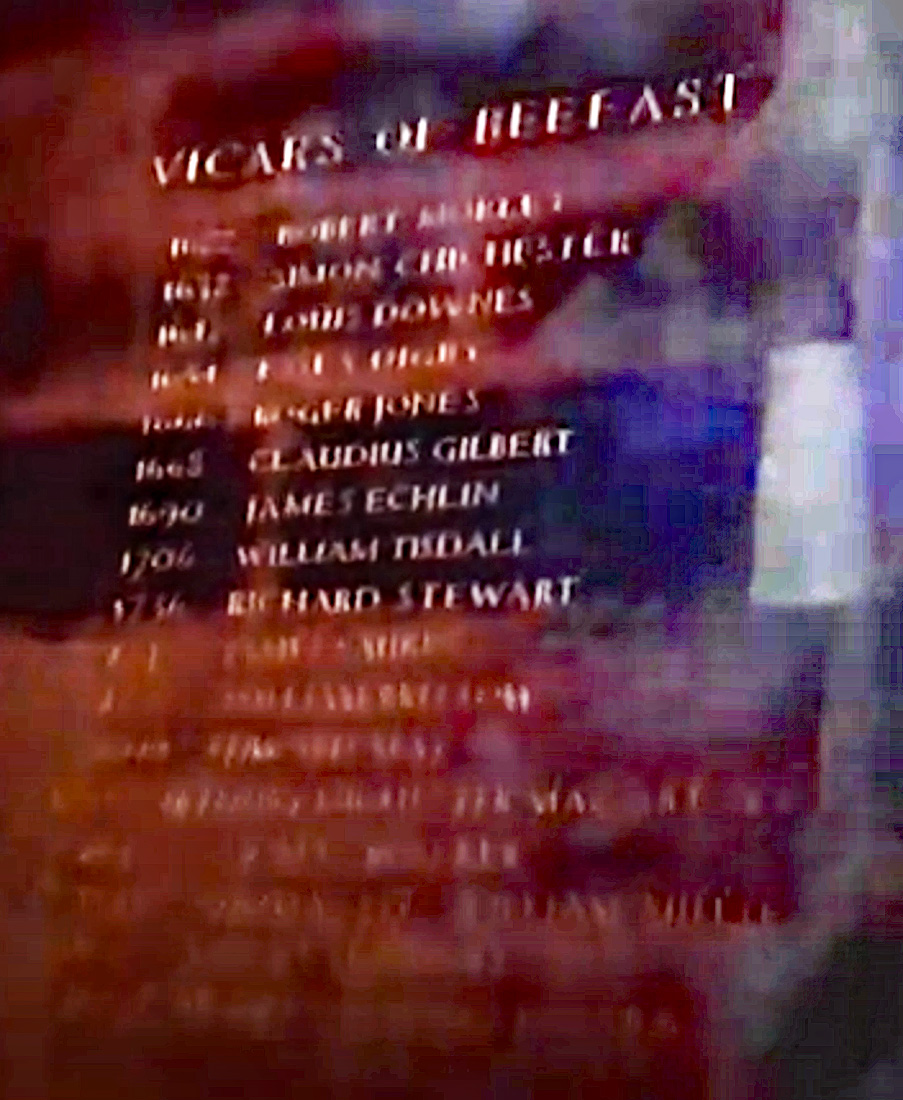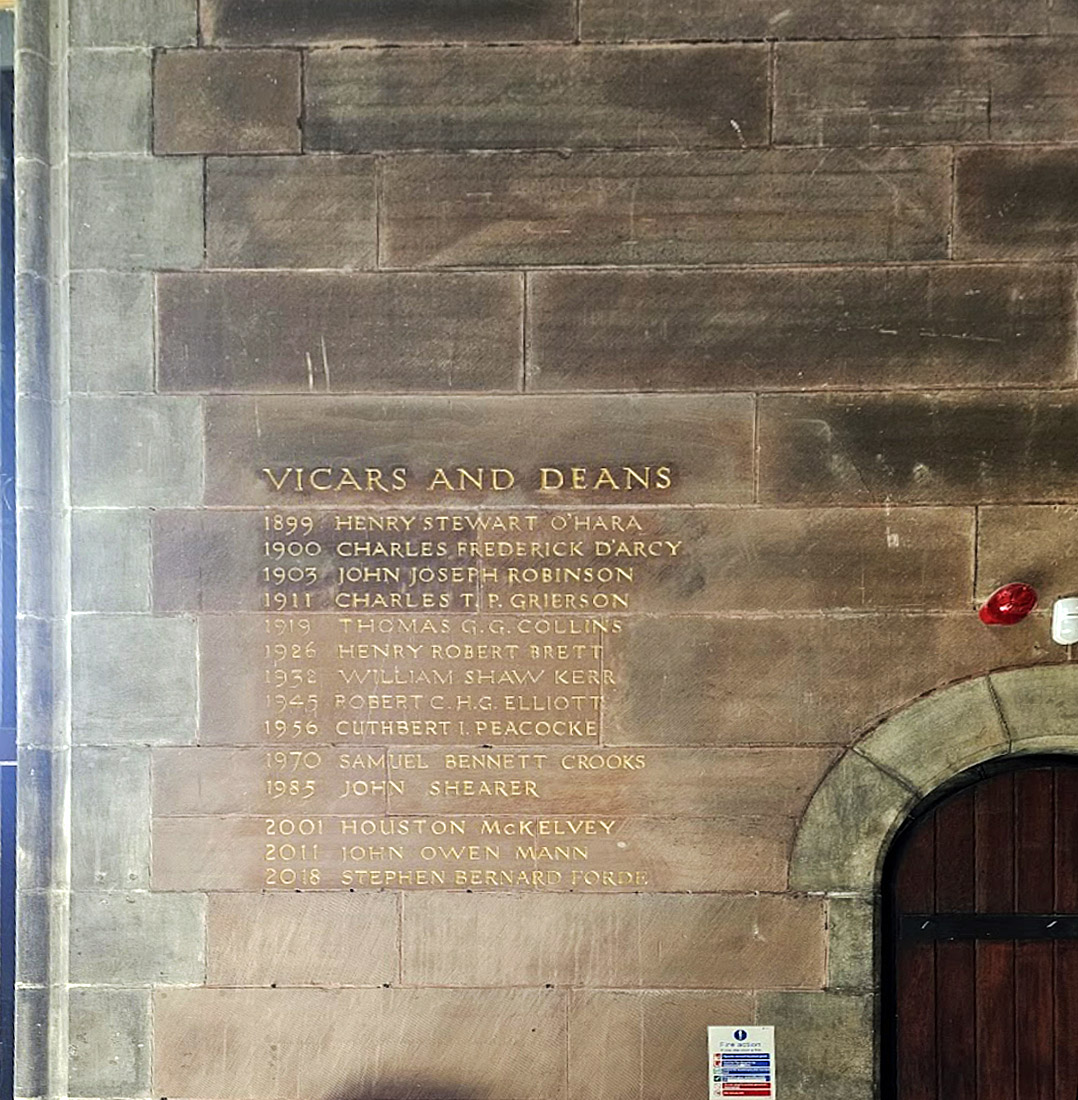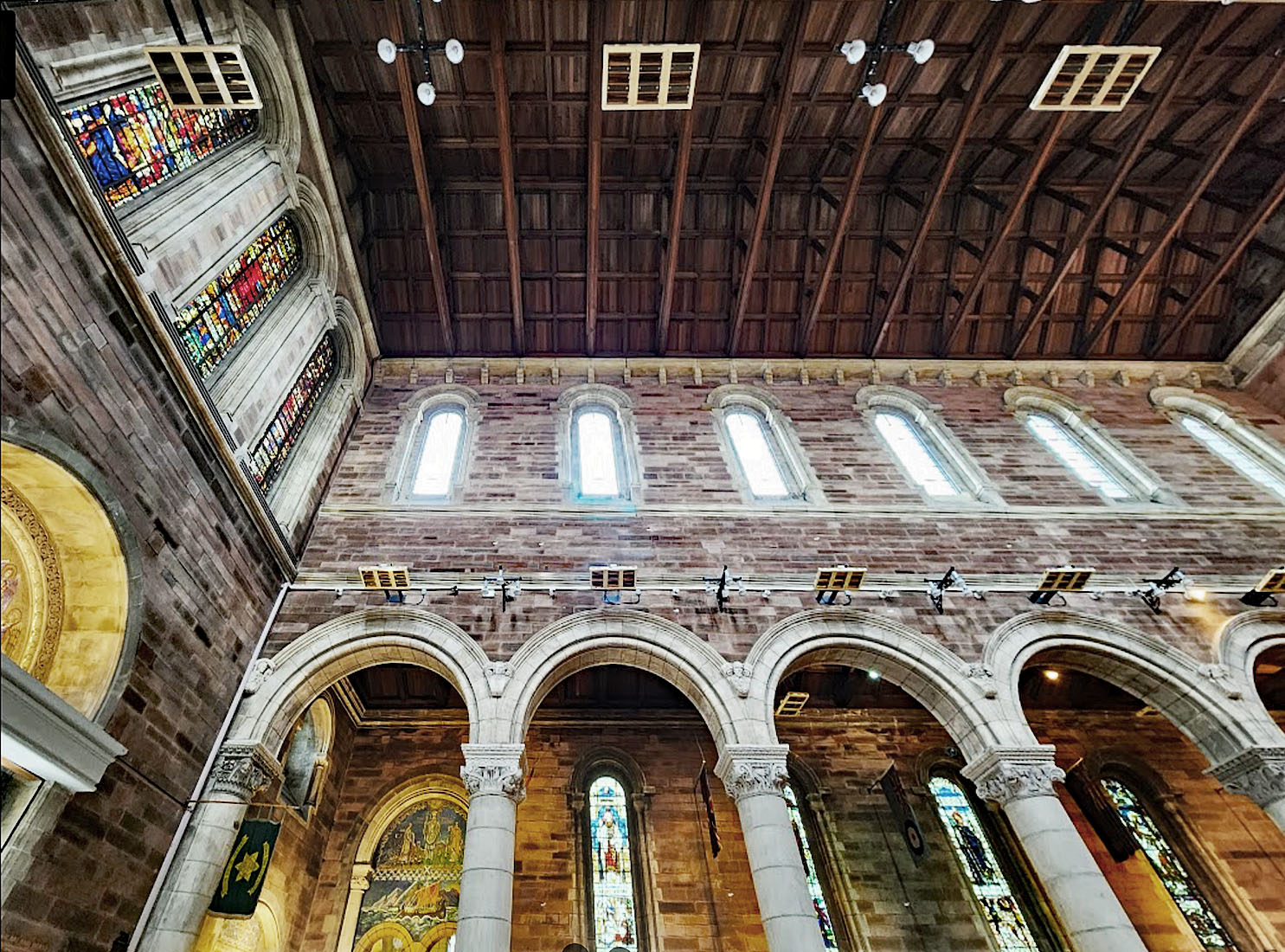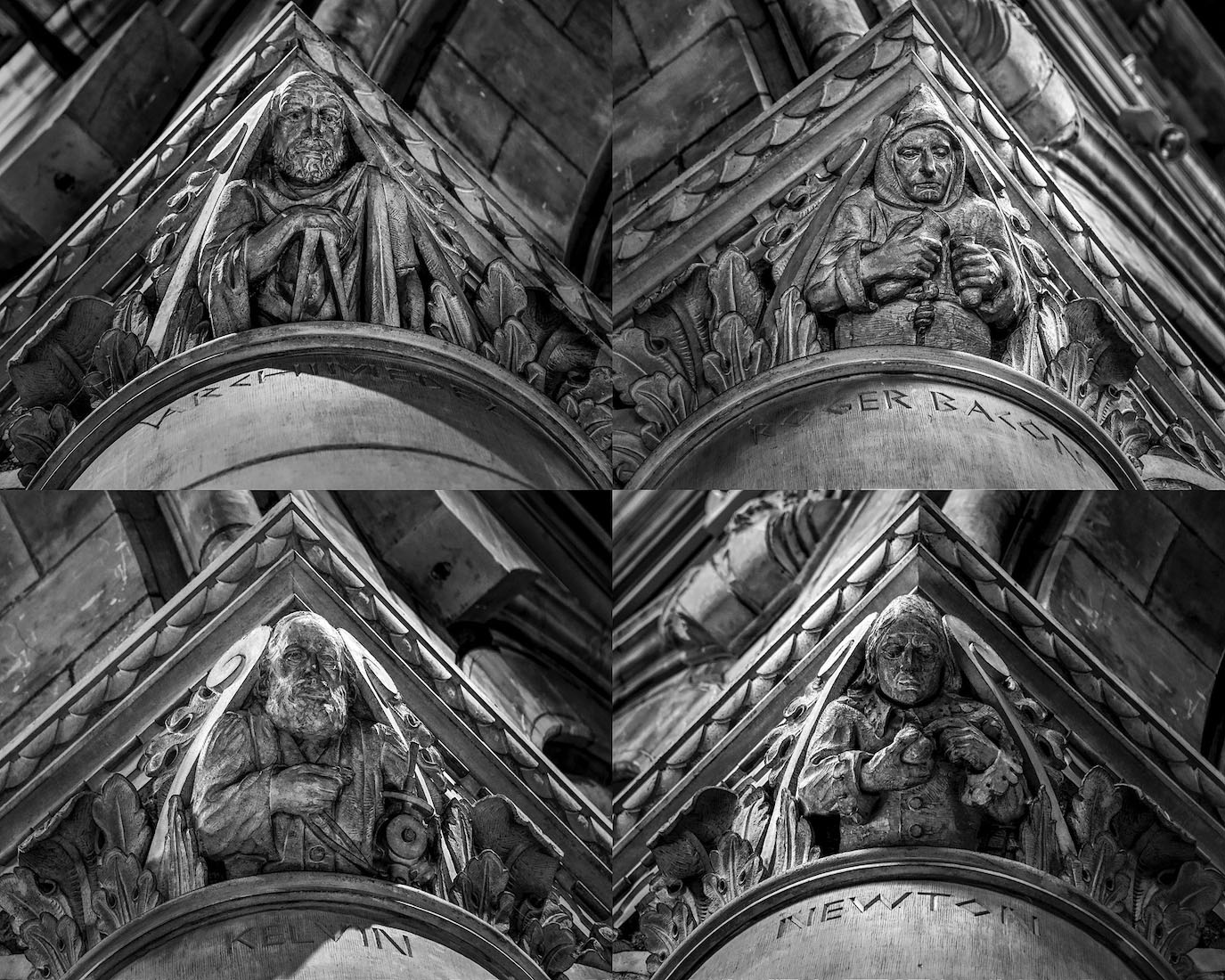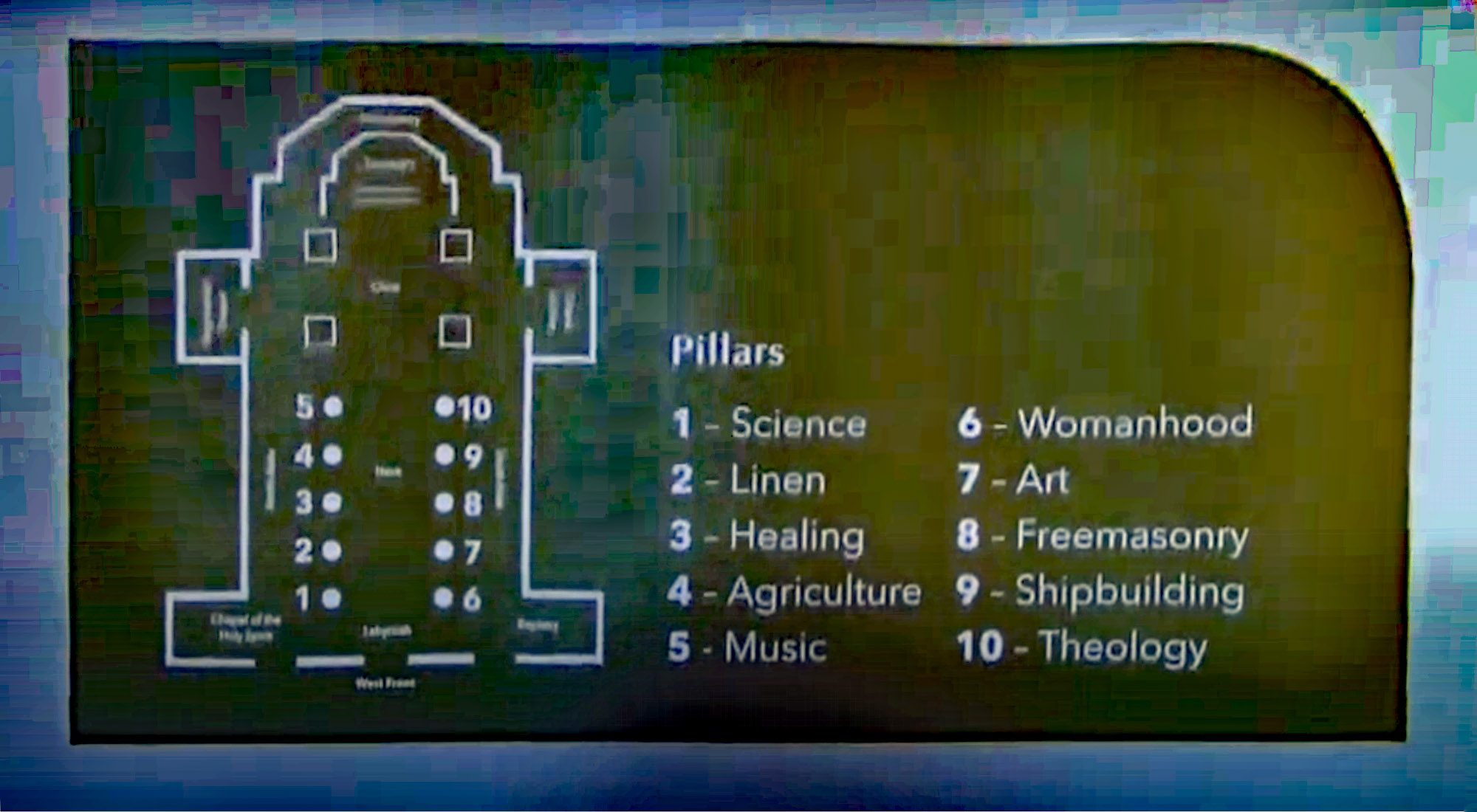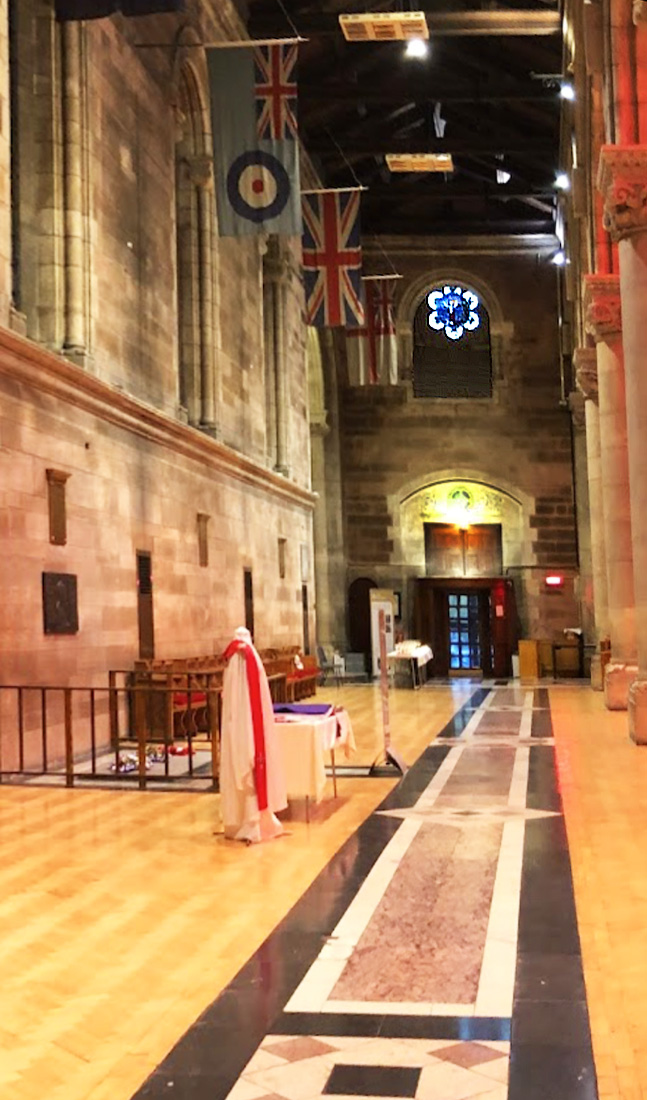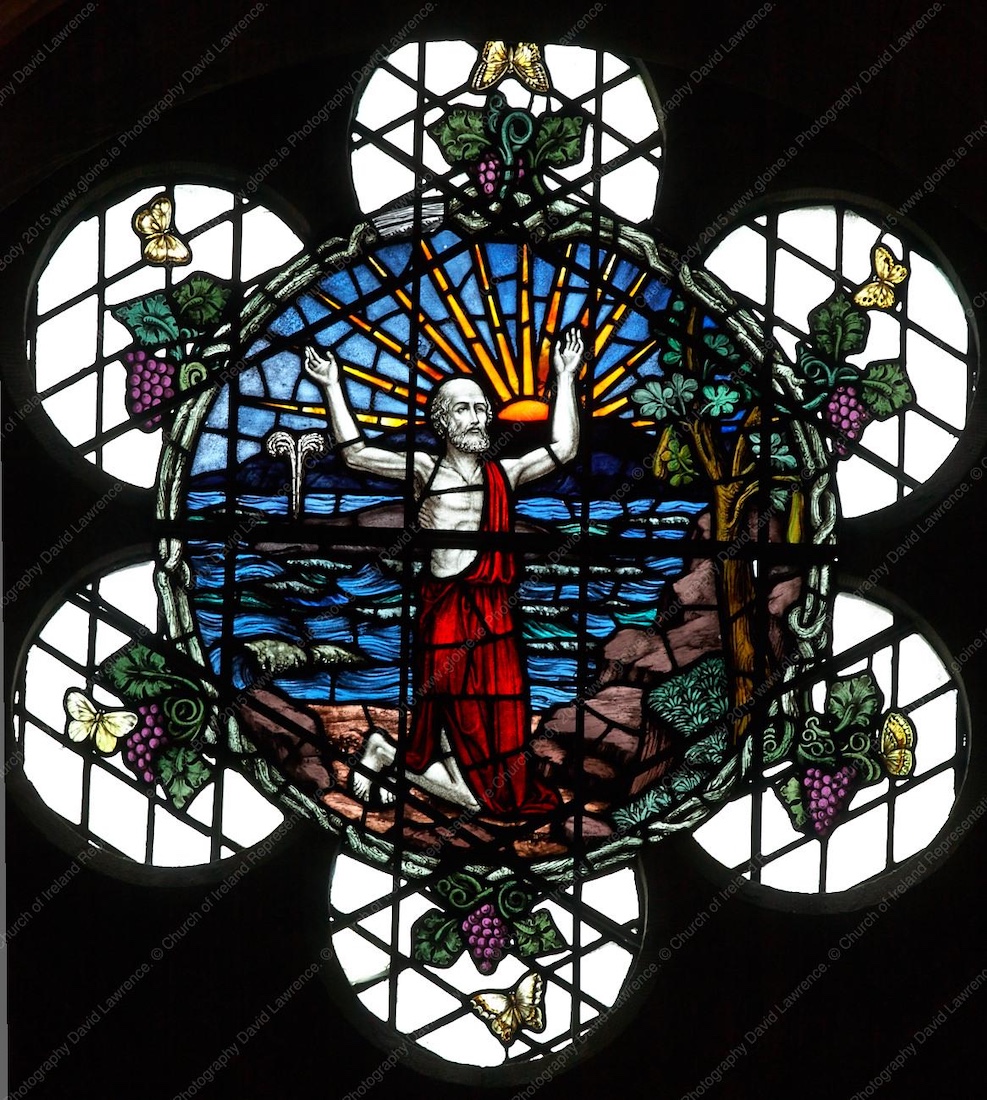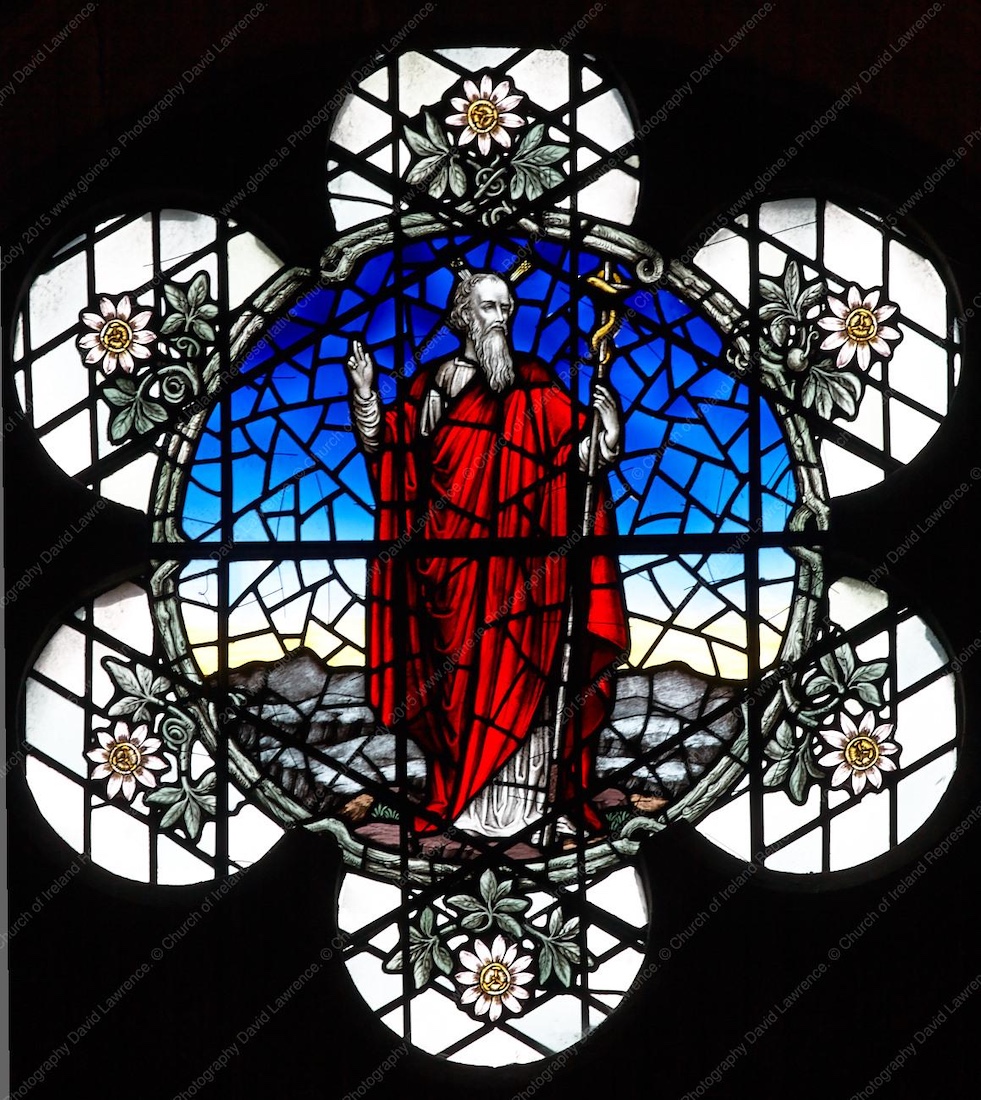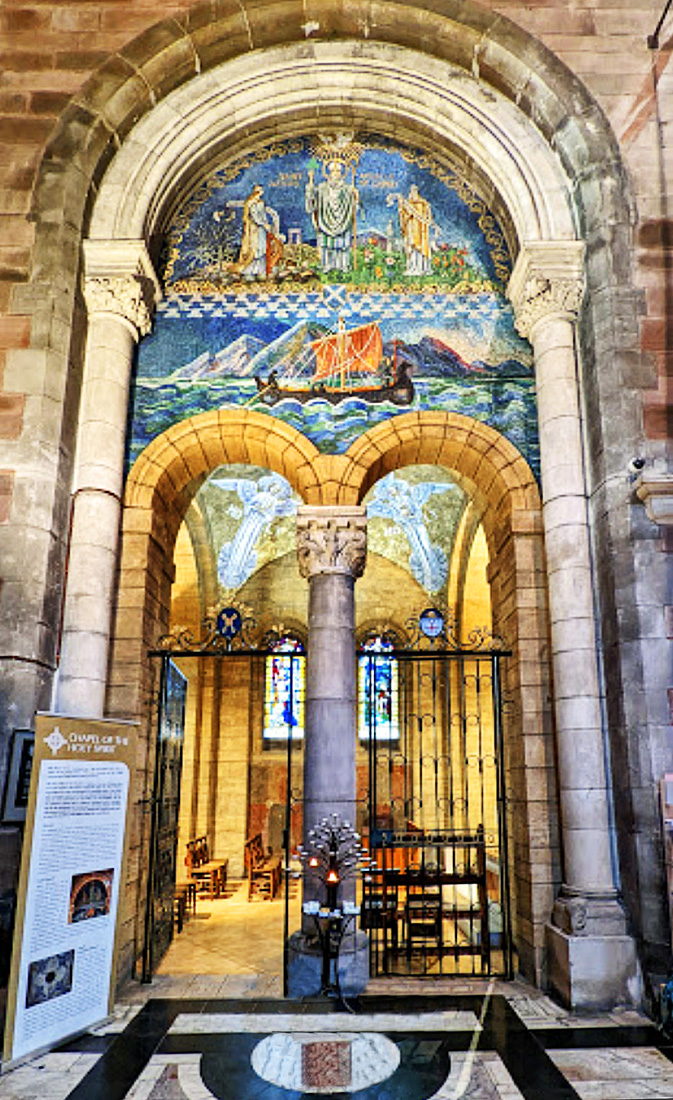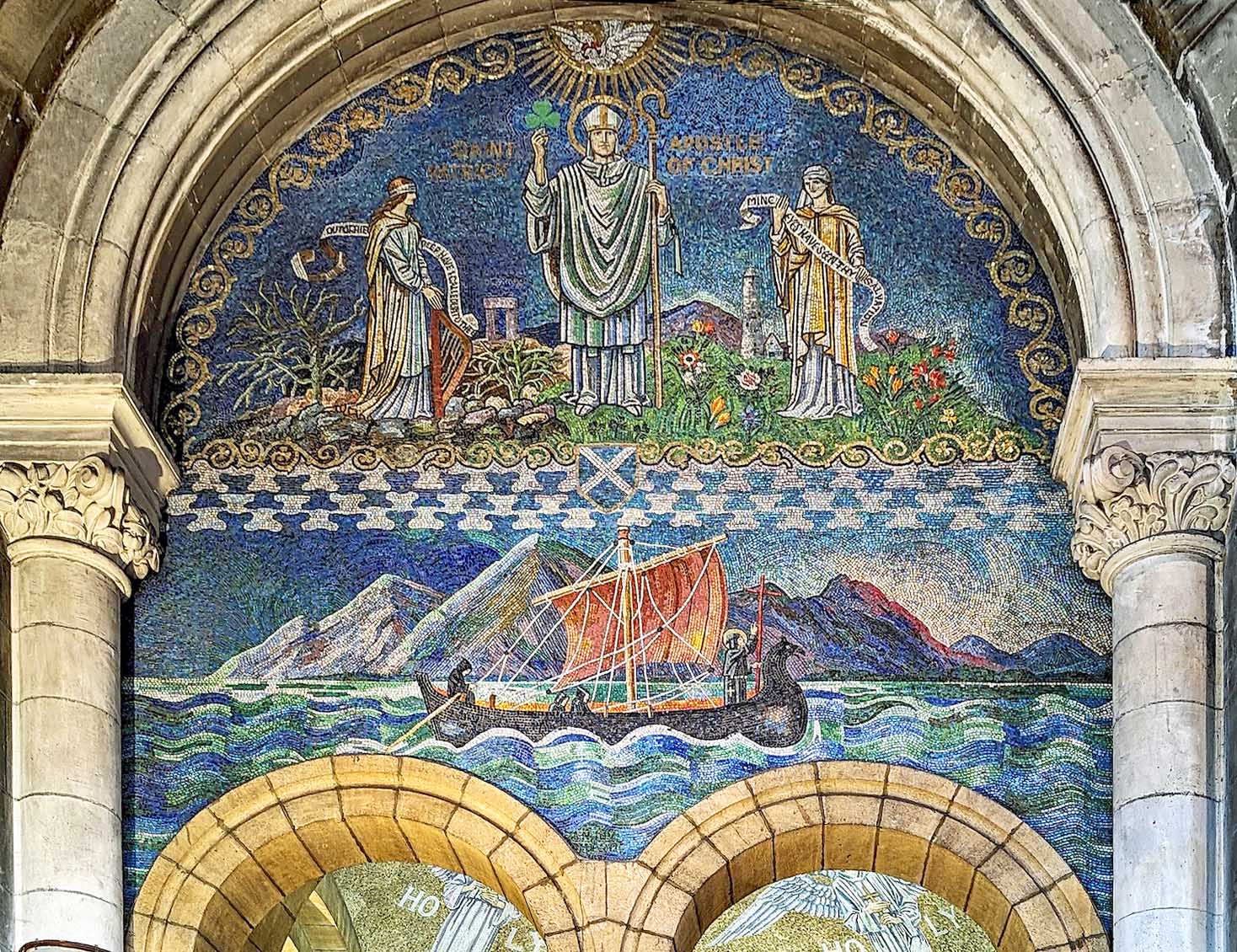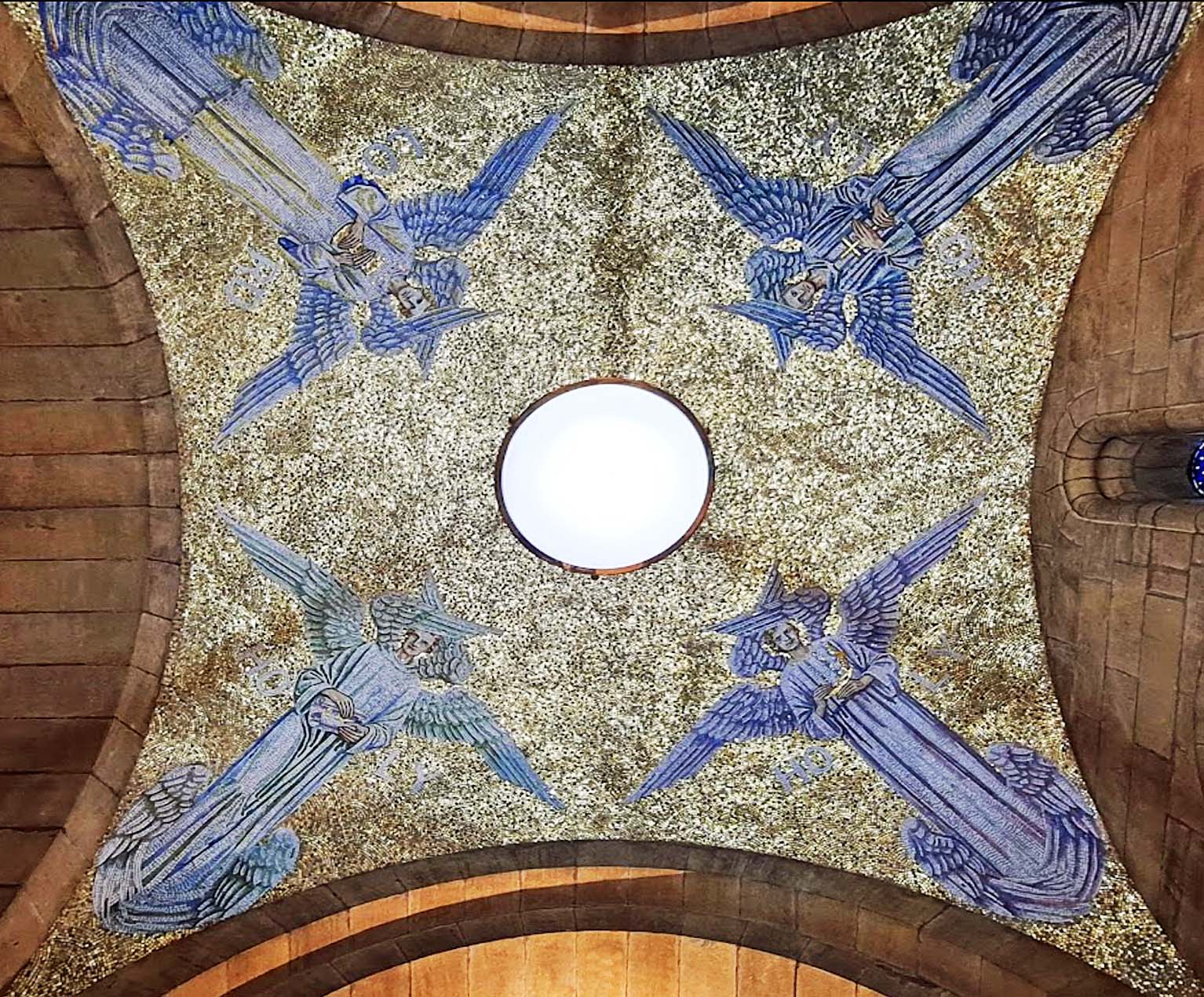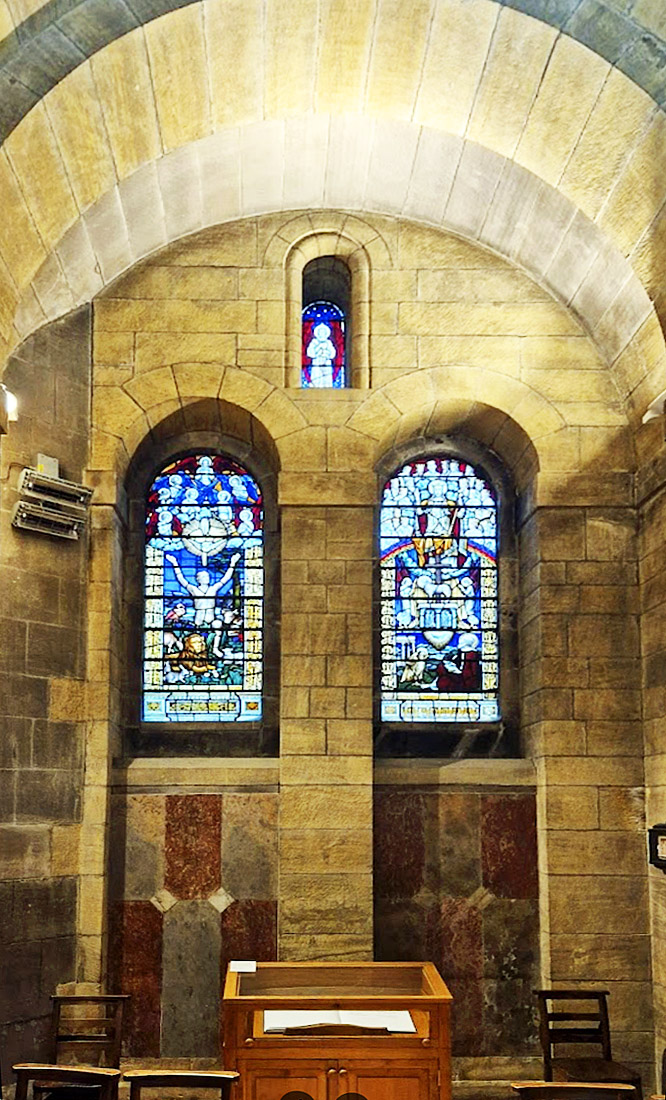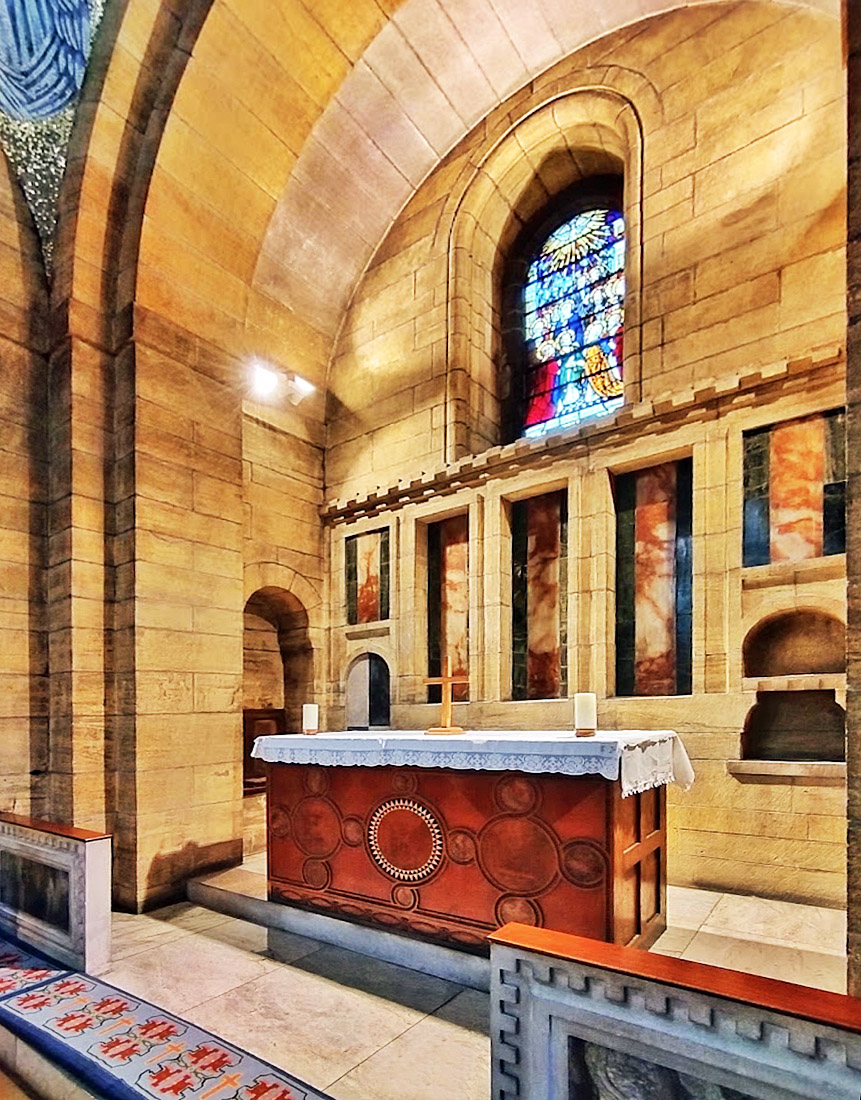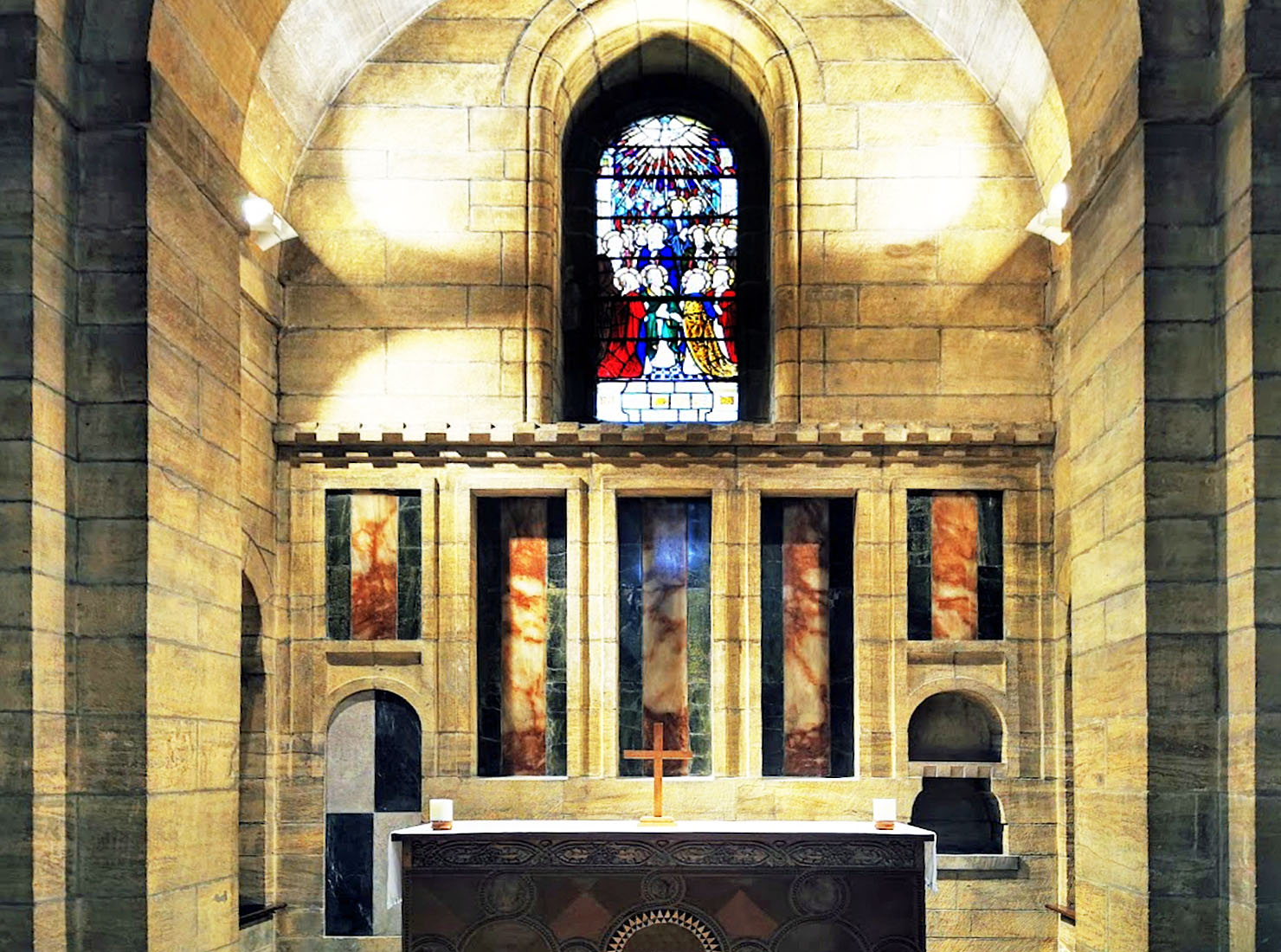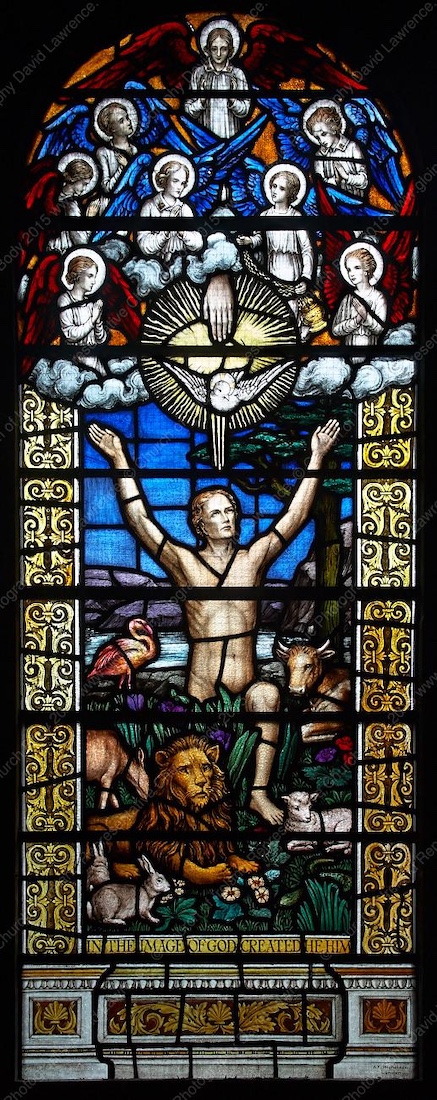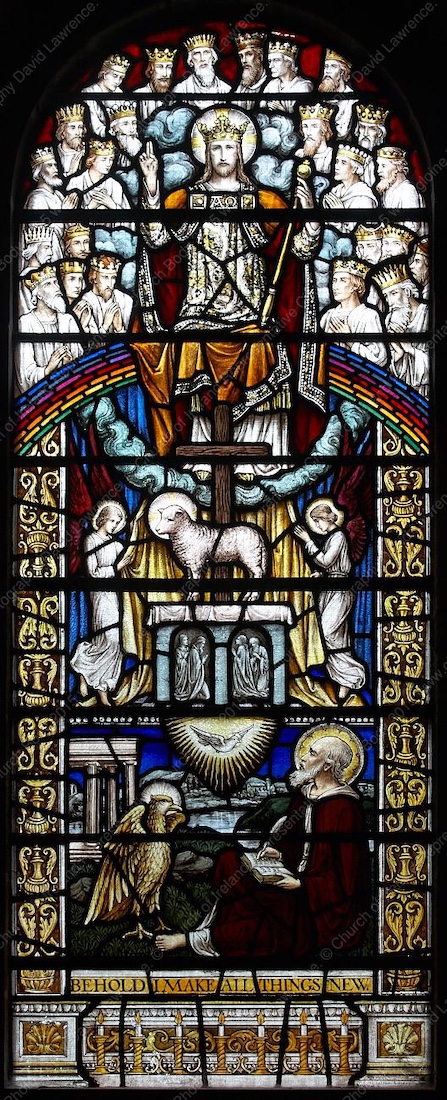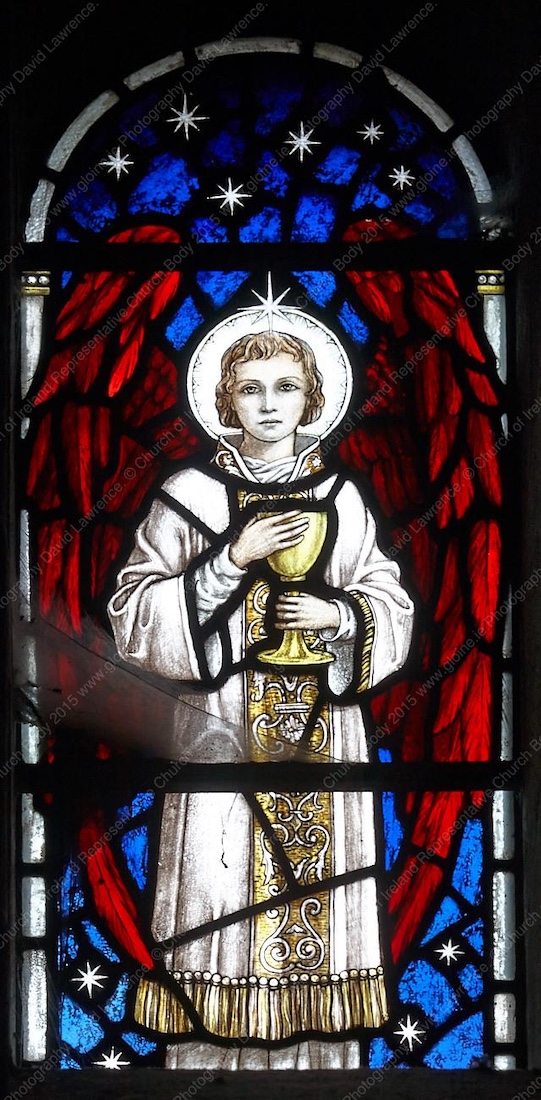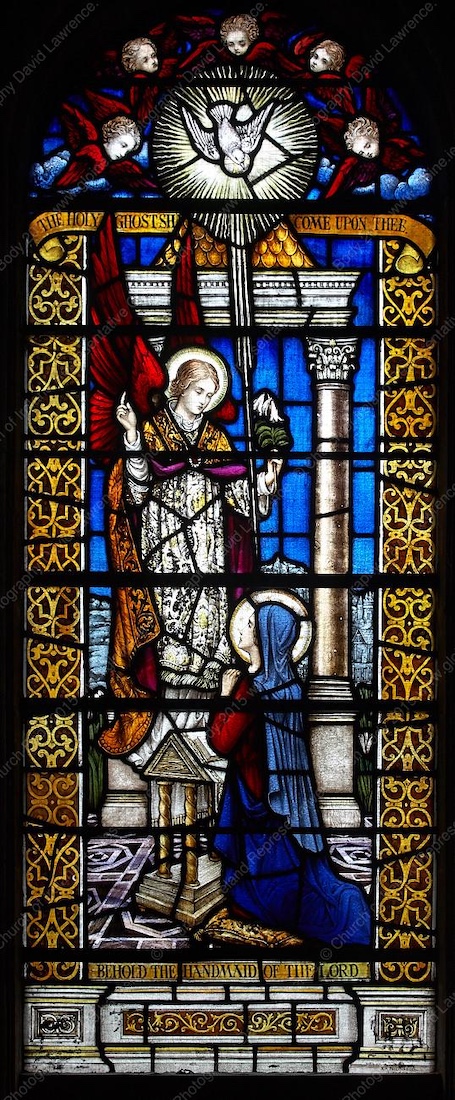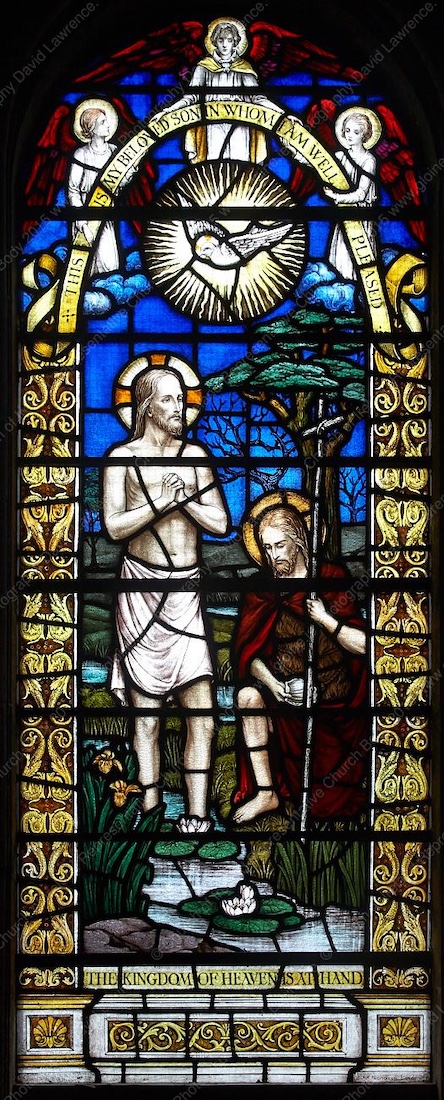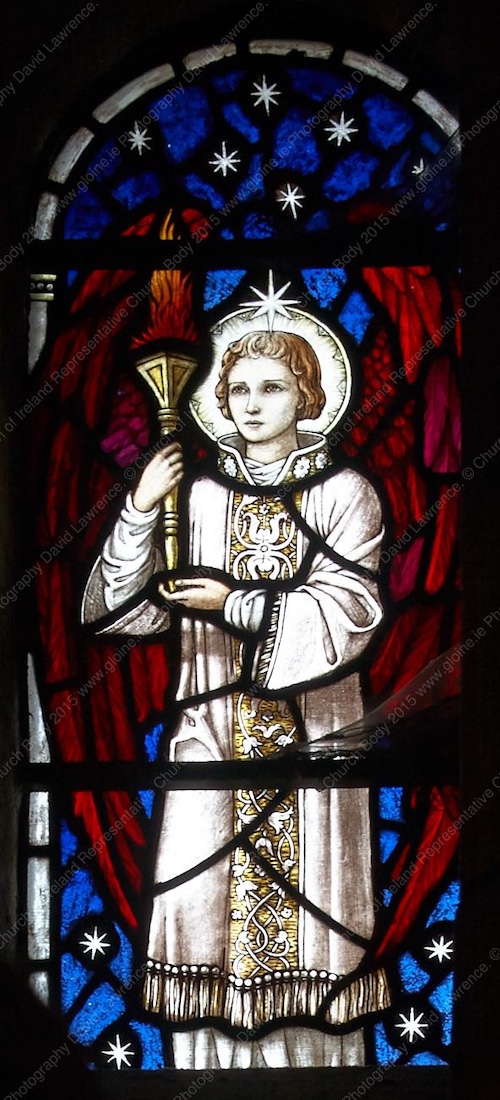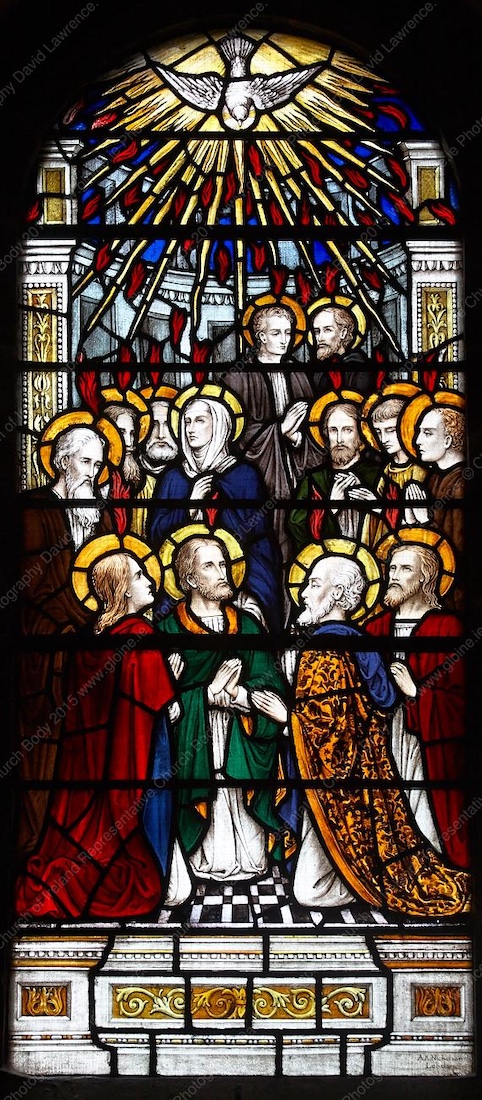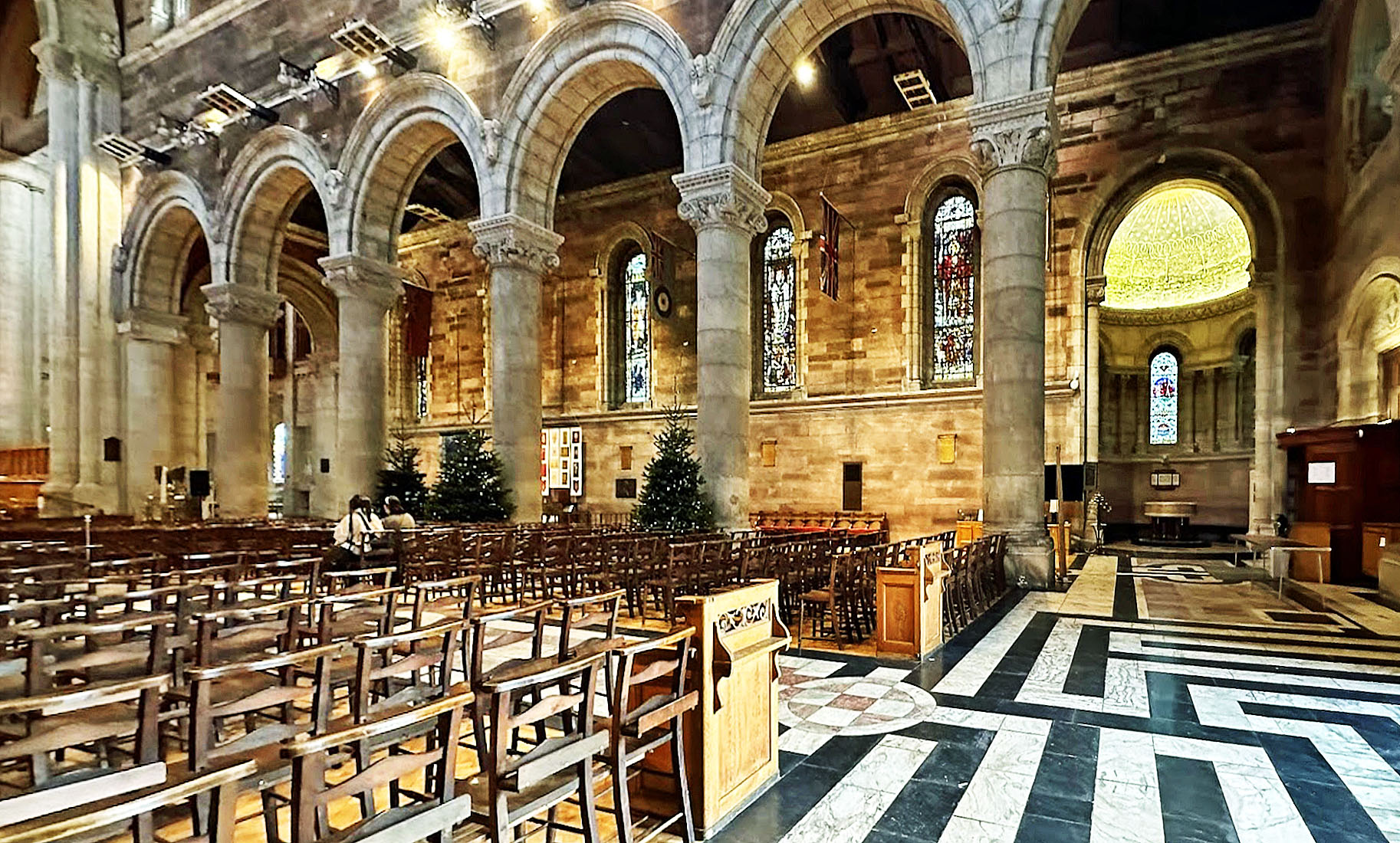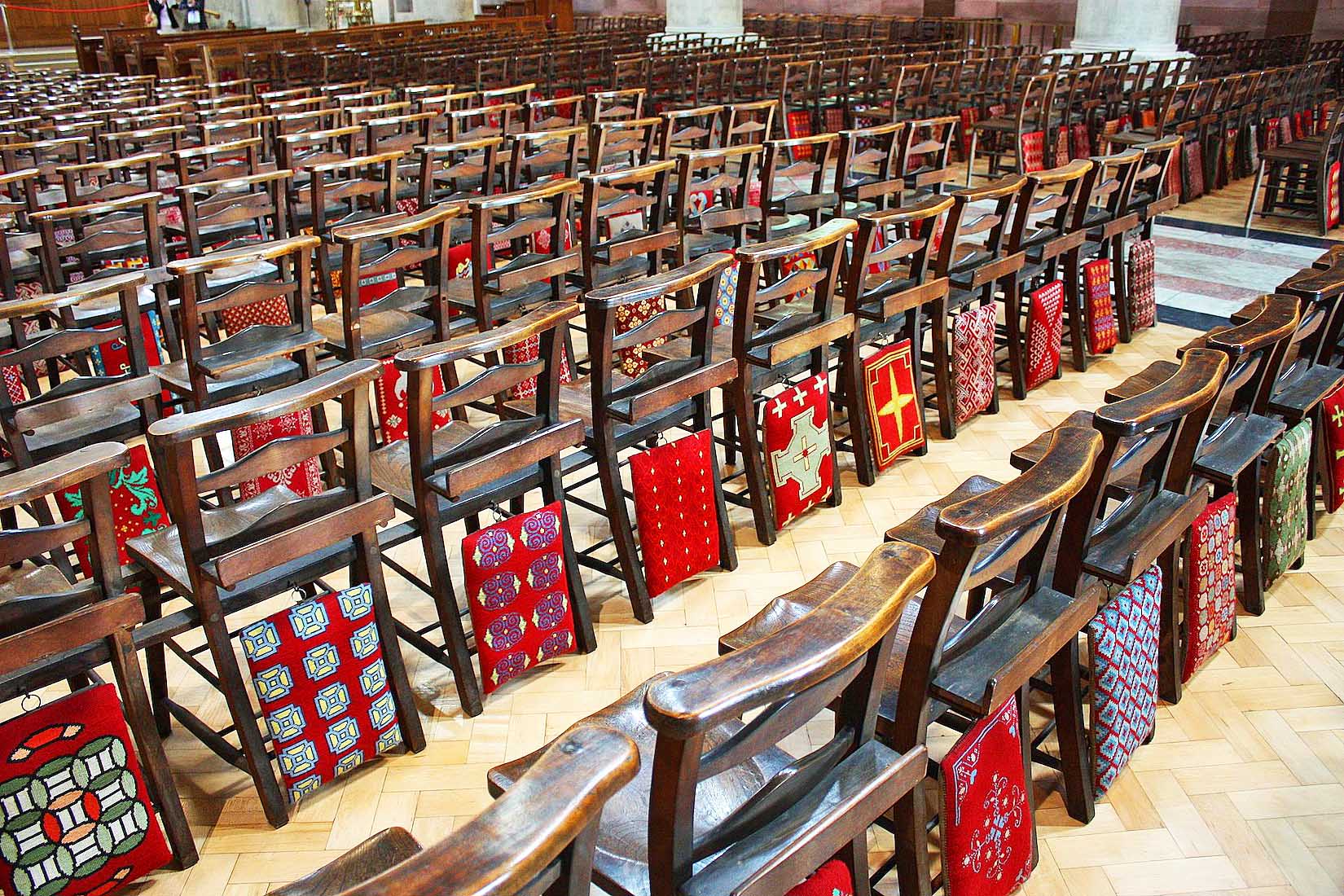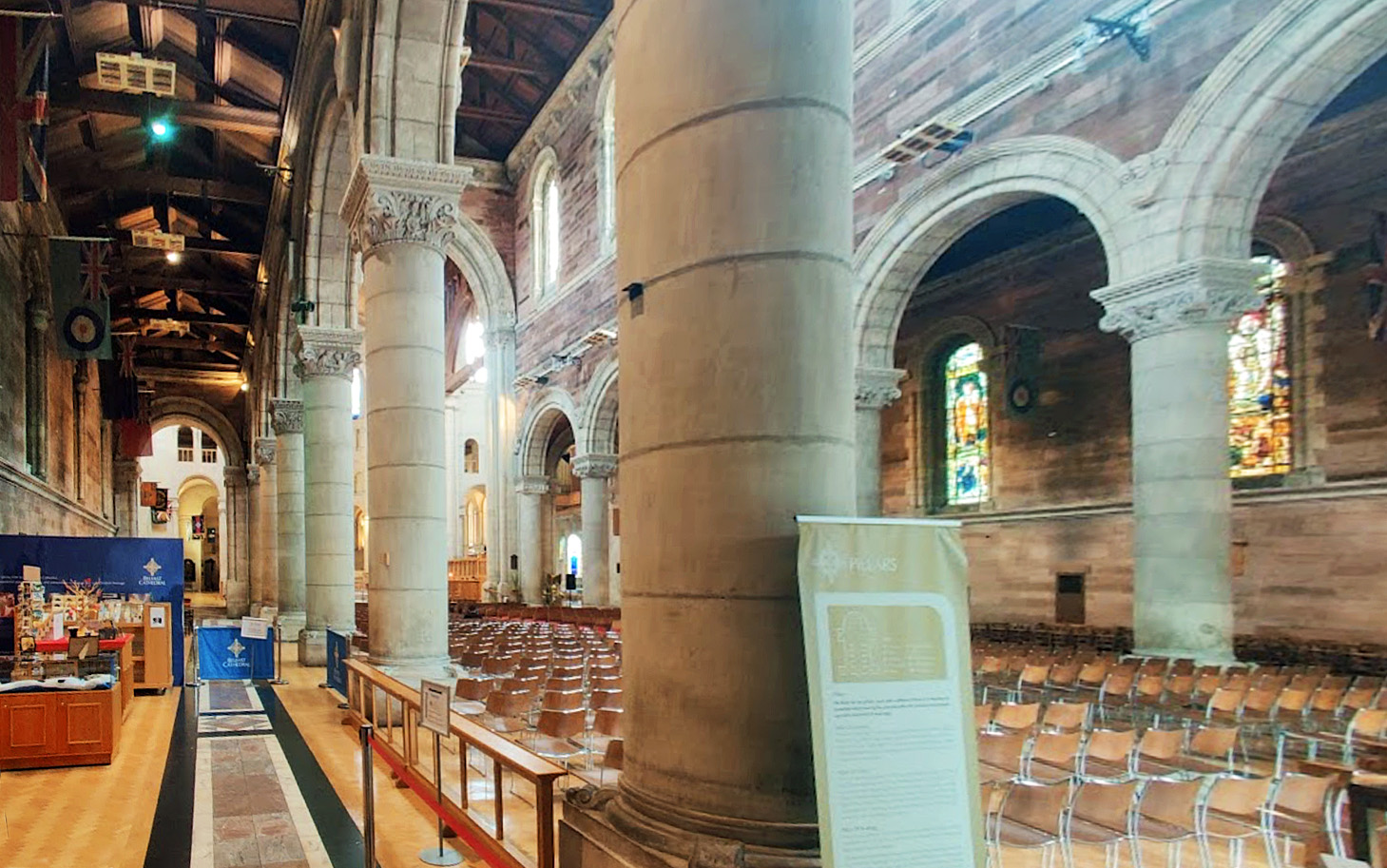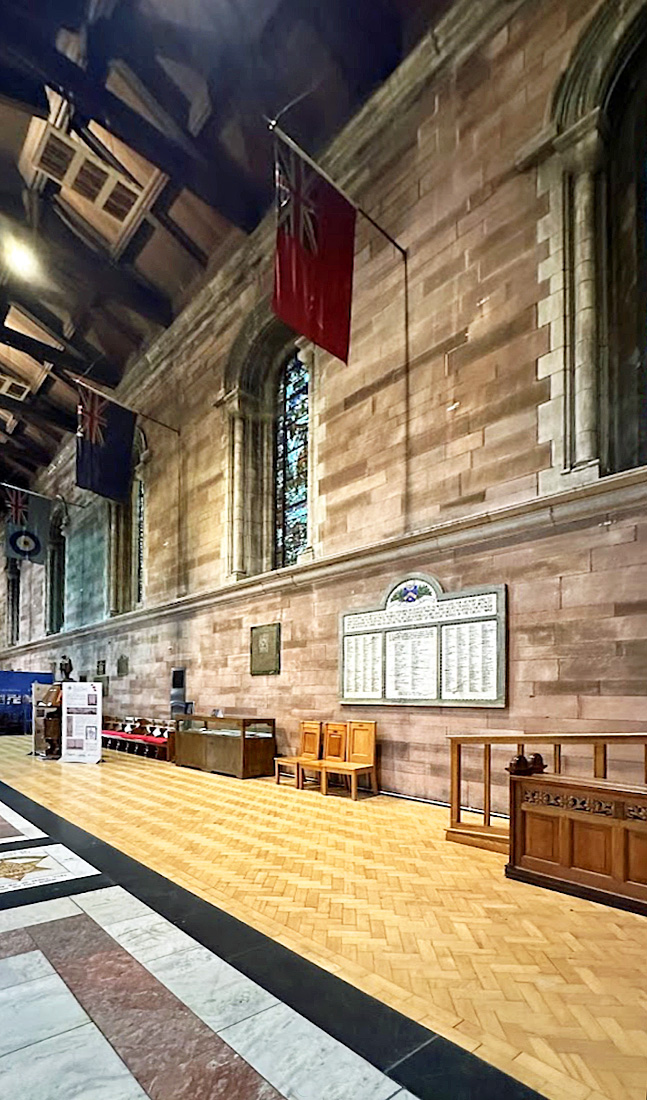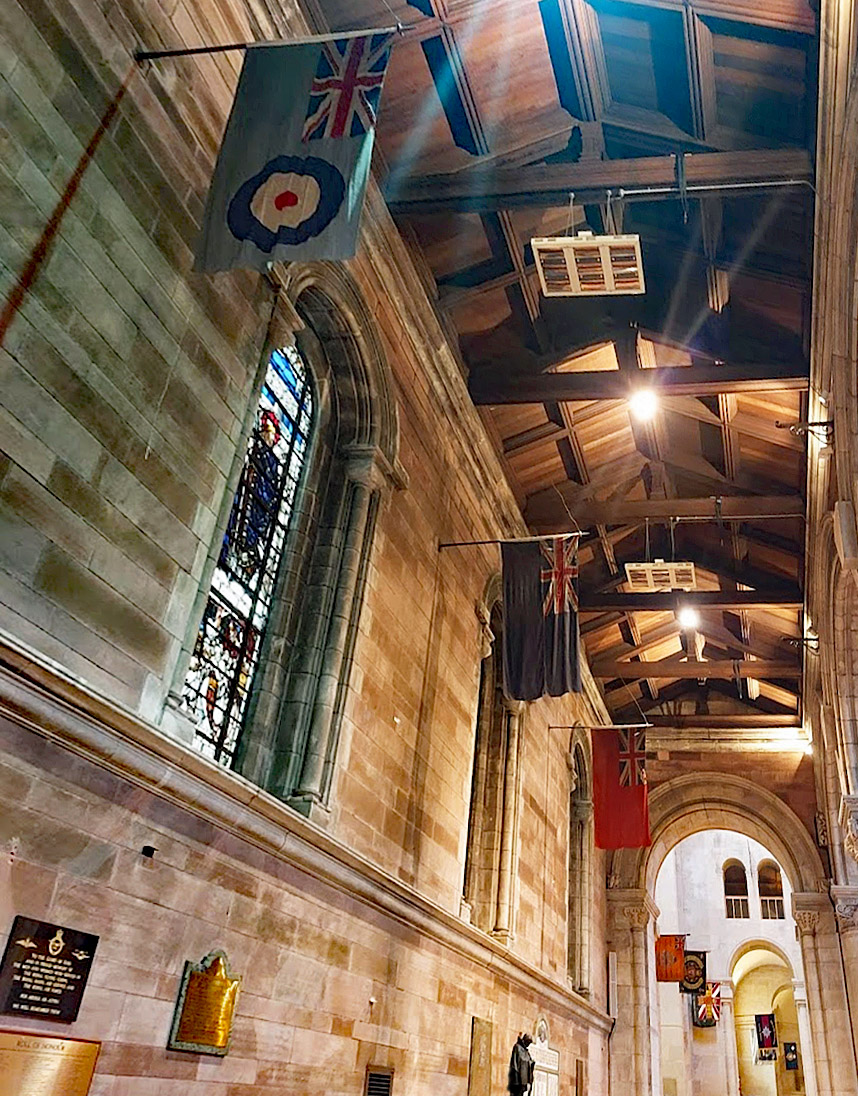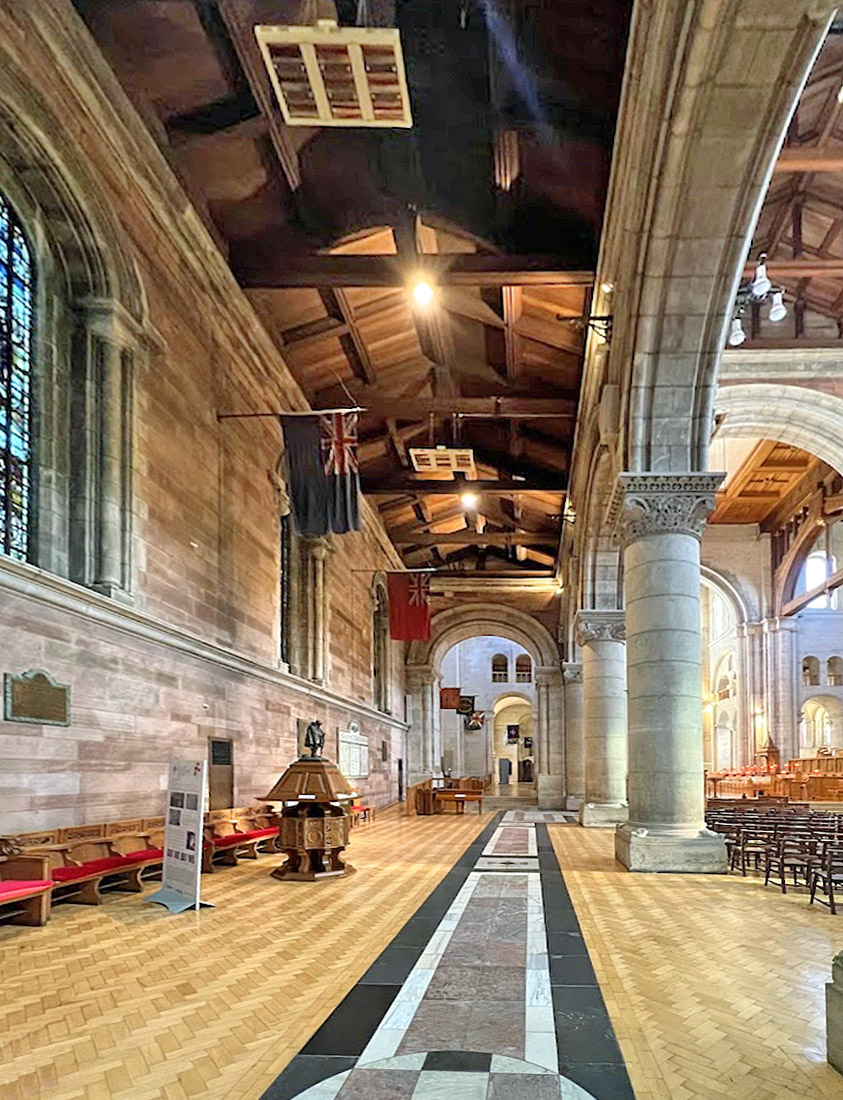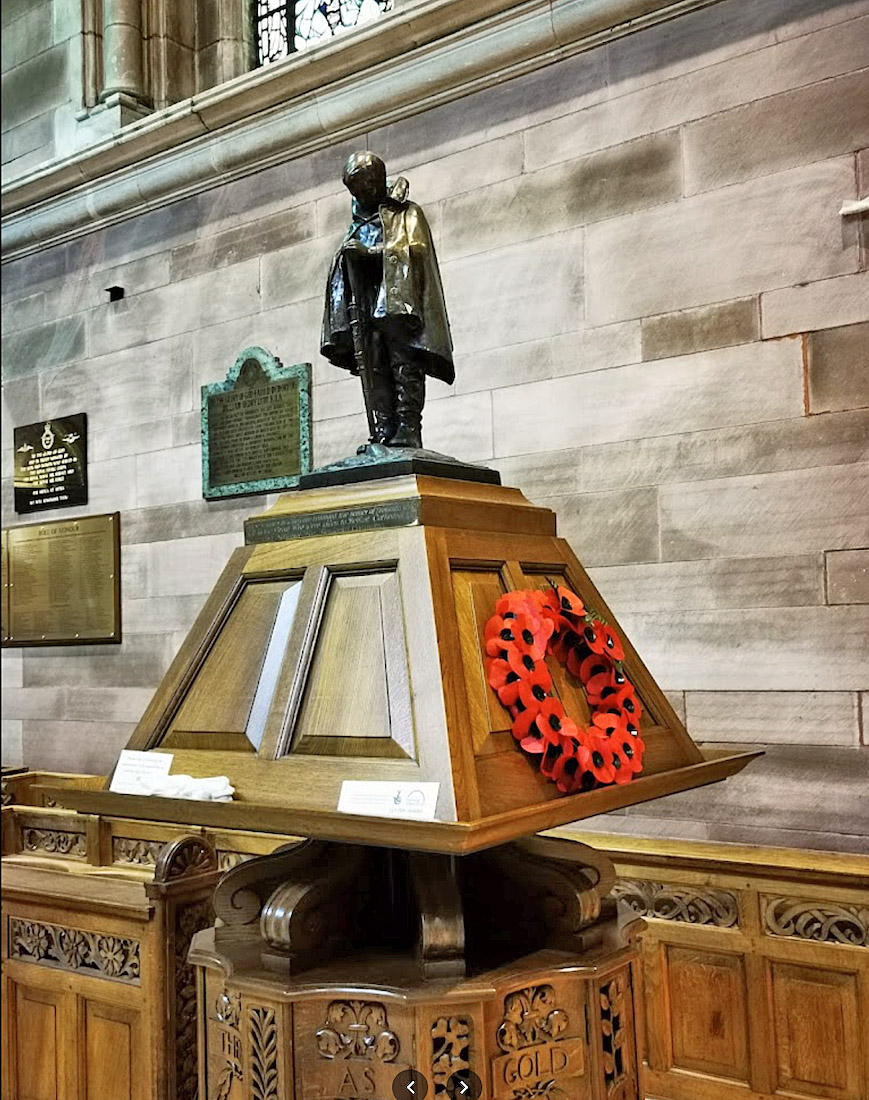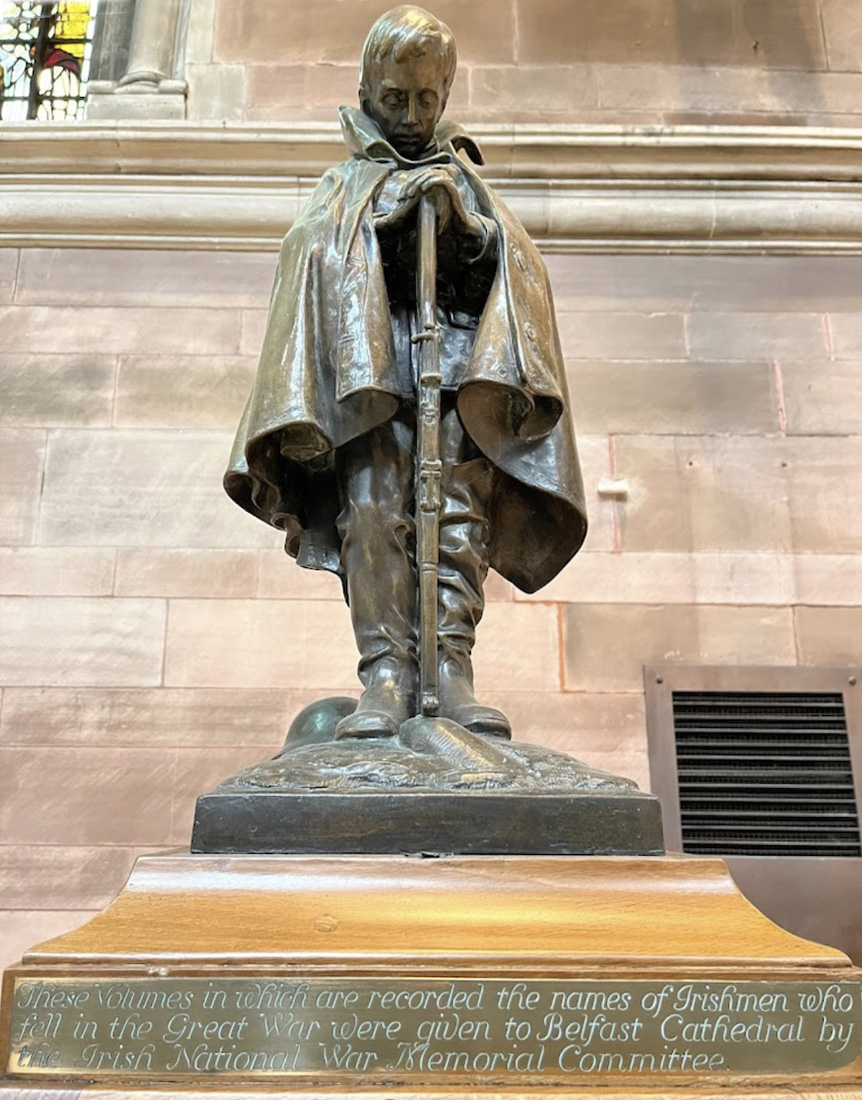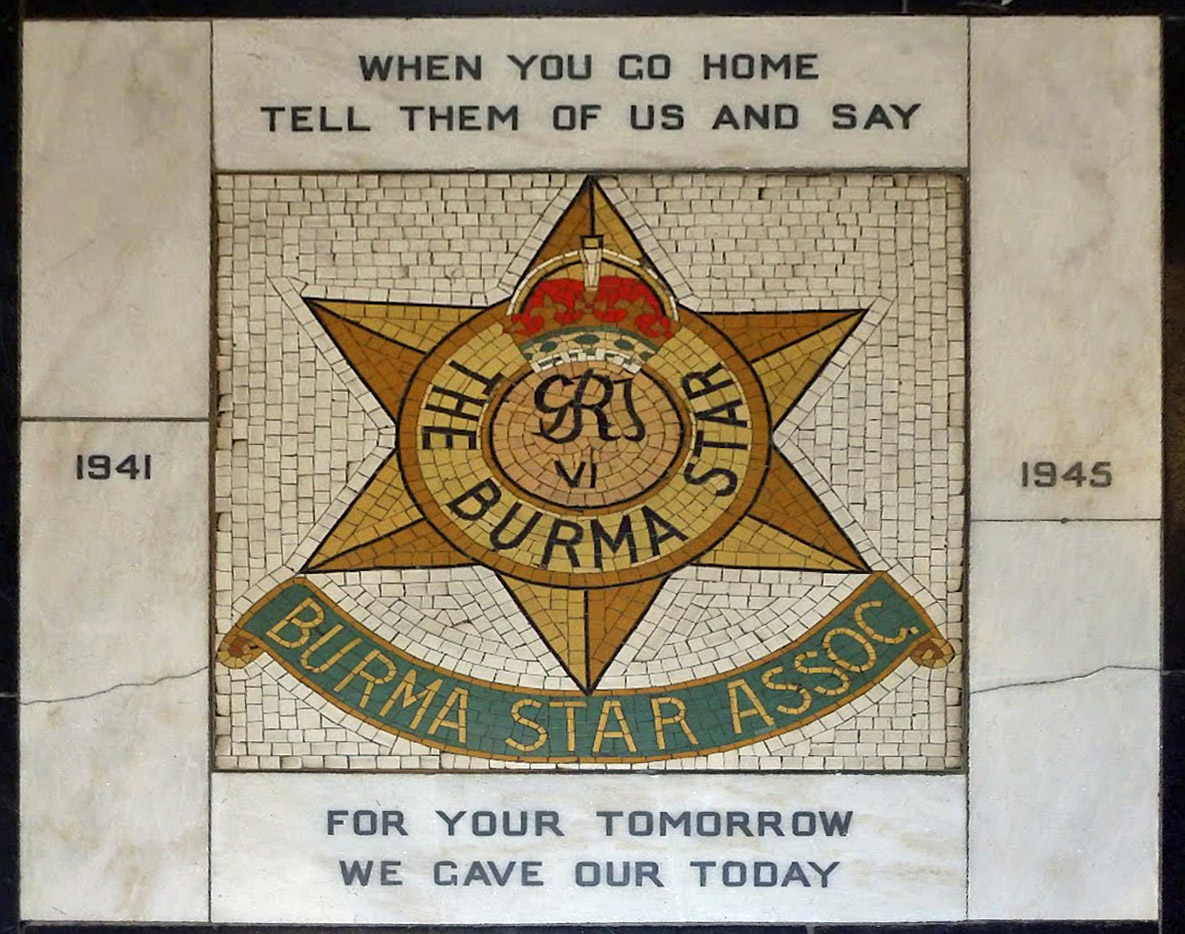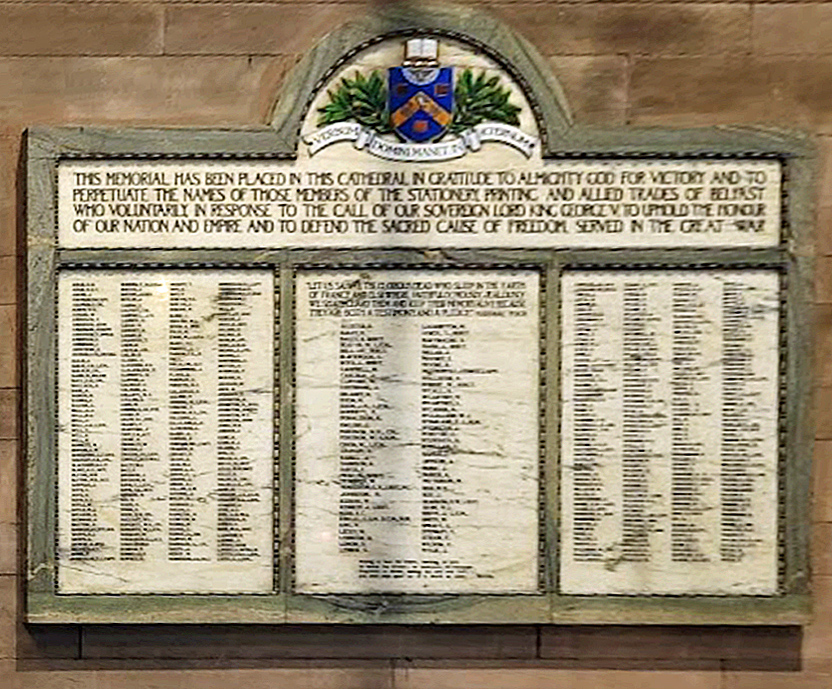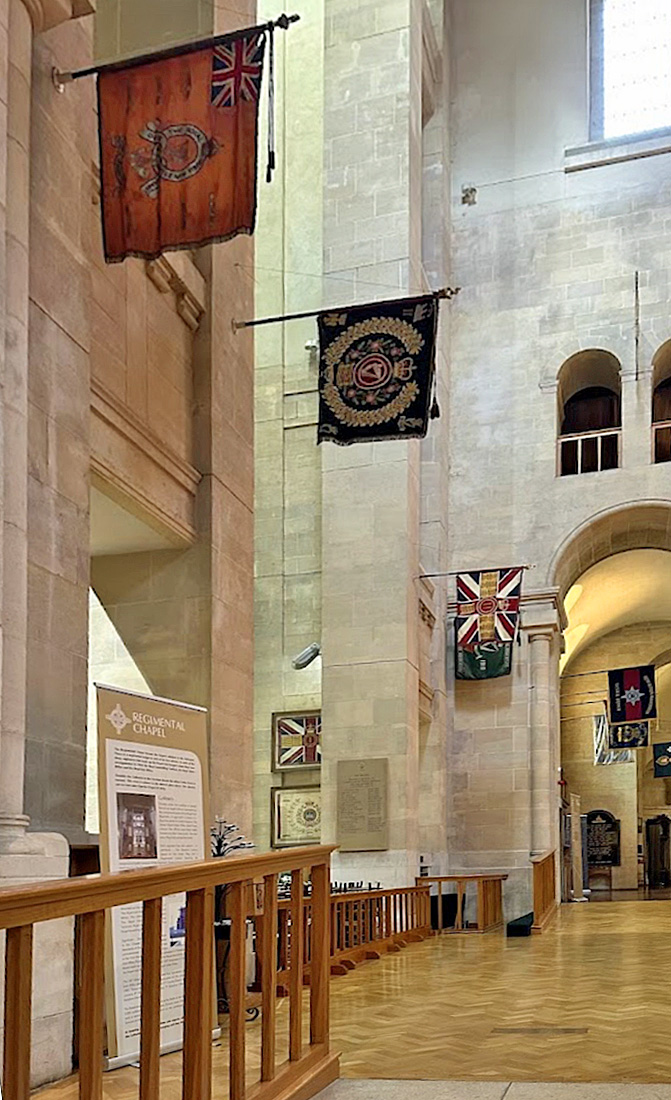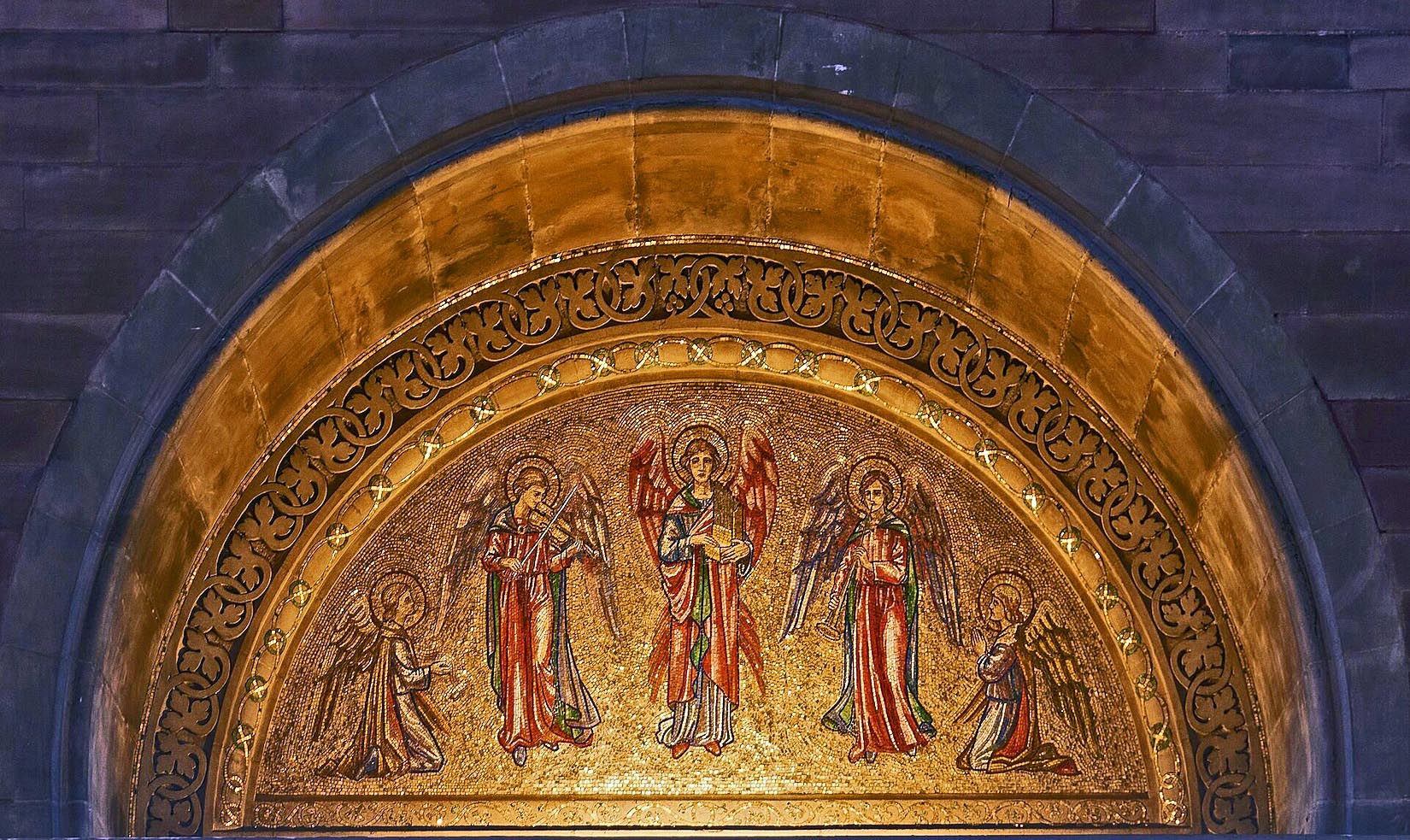
Closer examination reveals that the bright semicircle above the entry is in fact not a window, but a brilliant mosaic of musical angels. I read that this is a memorial to choir men who lost their lives in the 1914 – 1918 War. The various Cathedral mosaics of Italian glass are the work of two sisters, Gertrude (1881 – 1952) and Margaret Martin. [Photo Credit: Virtual-Pano] INDEX
22. RICHNESS OF THE NAVE Wiki
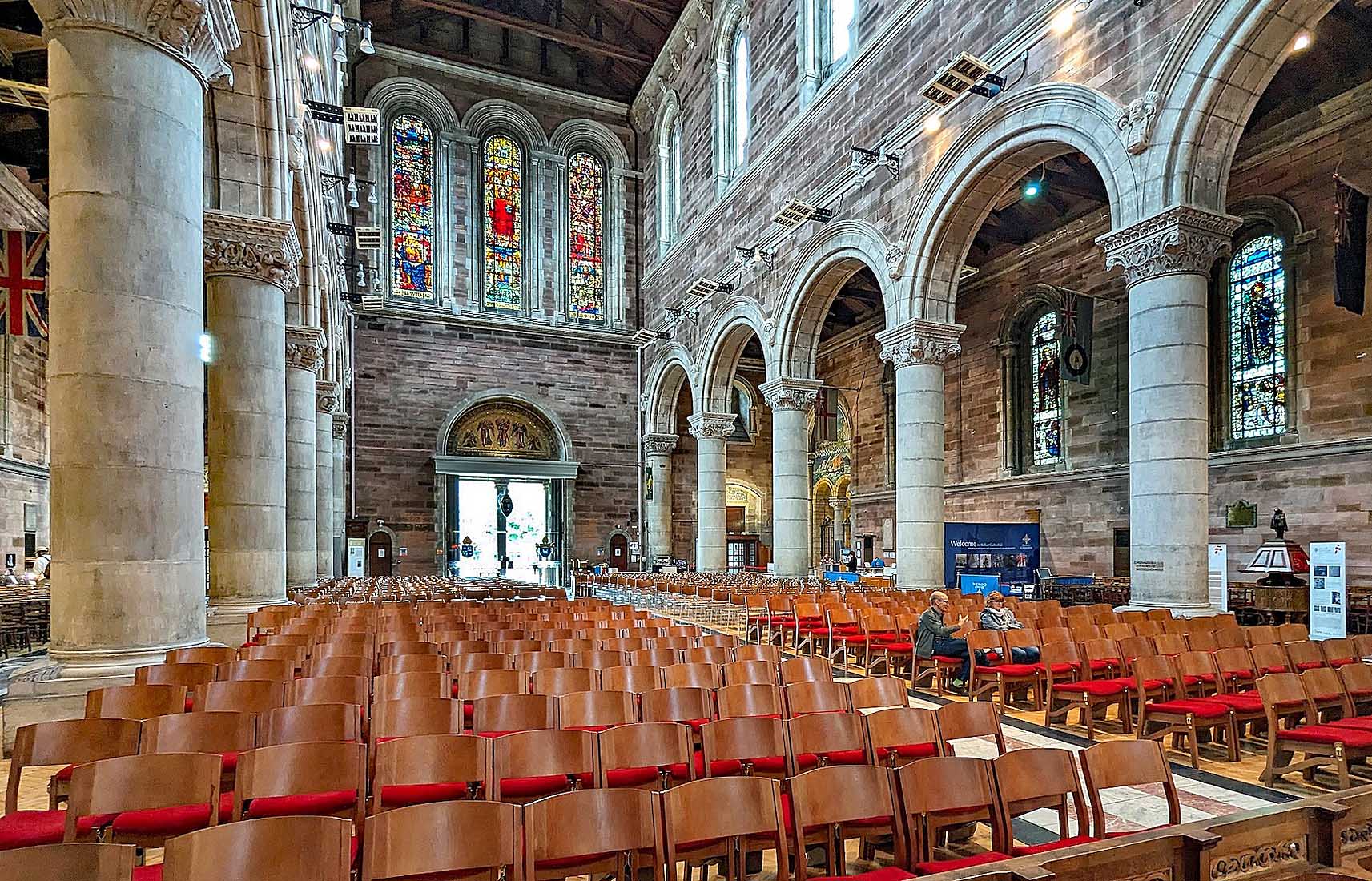
This view reminds us of the richness of the nave decoration, especially the tops of the columns. But there is a further detail here which might easily go unnoticed. [Photo Credit: PaulT]
23. VICARS AND DEANS TMV GSV
On either side of the West entry is a list of past vicars and deans of St Anne’s. Robert Morley is listed as the first Vicar of Belfast, but details and dates appear vague. The first Dean of Belfast was Henry Stewart O’Hara (1894 – 1899). [Photo2 Credit: Chuck Whitmore]
24. WEST WINDOW Gl x3
Looking back up the nave we get a great view of the West Window, set high above the entrance, and made up of three stunning stained glass panels. Each one is 25 feet tall and 5 feet wide. The left panel shows David (10th C BC – 9th C BC), the father of Solomon (970 BC – 931 BC) who is shown in the right panel. Solomon was the builder of the First Temple in Jerusalem, around the 10th century BC. David is referenced in the Bible as the David who beat Goliath, and he was also the King of Israel. The centre panel features Christ himself, surrounded by angels, with the Lamb of God at the top of the window, and the Water of Life at the bottom.
25. SOME NAVE DETAIL GSV
In our investigation of St Anne’s we look in turn at the pillar capitals, the round West windows (one of which can almost be seen here!), and the Chapel of the Holy Spirit. [Photo Credit: Marie Stephens]
26. PILLAR CAPITALS Wiki TMV
The capital of the first pillar on the North side of the central aisle is dedicated to science, and features the busts of Archimedes, Roger Bacon, Kelvin and Newton. Each pillar capital has a different theme, and these are outlined on a nearby information board. These carvings are chiefly by Morris Harding. [Photo1 Credit: August Schwerdfeger]
27. SIDE WEST WINDOWS GSV Gl Gl
There is a ‘round’ window high up above each of the side West doors. The South aisle view at left shows the placing of one of these windows. The South window shown at left shows Jonah. The North window at right shows Moses and the Brazen Serpent. Both windows date from ca 1927 and were given by C.A. Nicholson. They were produced by the A.K. Nicholson studio in London. [Photo1 Credit: Maged Michael]
28. ENTRY TO CHAPEL OF THE HOLY SPIRIT GSV Wiki
Right close to the Northwest corner of the nave is the entry to the Chapel of the Holy Spirit. This chapel with its beautiful entry mosaic depicting St Patrick, was dedicated in 1932, the 1500th anniversary of the arrival of St Patrick in Ireland. The mosaic was by sisters Gertrude and Margaret Martin. [Photo1 Credit: Luis Calvo Ramos] [Photo2 Credit: PaulT]
29. CHAPEL CEILING GSV
Entering the Chapel we stand beneath the mosaic ceiling: four wonderful blue angels. If we look very carefully, we will see the text ‘Holy, Holy, Holy Lord’. [Photo Credit: Andrew Grieg]
30. WEST WALL OF CHAPEL GSV
We find on the West wall to our left a small display cabinet with a book of remembrance. [Photo Credit: Stuart Hurcombe]
31. CHAPEL ALTAR GSV GSV
On the Eastern side of the Holy Spirit Chapel is an altar with central cross and a candle on either side. Behind the altar is a window, and a wall with interesting mounted marble panels. An aumbry sits in a niche to the left of the altar. [Photo1 Credit: Raisa Mehbaba] [Photo2 Credit: Colette Halliday]
32. WEST WALL CHAPEL WINDOWS Gl (x3)
There are six stained glass windows in the Chapel. Here on the West wall are three of them: the left window depicts Adam, the centre, the Apocalyptic Vision of St John. Both windows date from ca 1932, and both come from the A.K. Nicholson Studio in London. And above is the window showing a charming little angel with red wings holding a chalice.
33. REMAINING CHAPEL WINDOWS Gl (x4)
There are four remaining stained glass windows in the Chapel: three on the North wall facing the entrance, and a smaller one on the East wall above the altar. From left to right they depict The Annunciation, the Baptism of Jesus, Angel of Light, and Pentecost. All of these windows date from ca 1932, and were produced by A.K. Nicholson Studios in London.
34. VIEW ACROSS NAVE GSV
Leaving the Chapel of the Holy Spirit, we look across the nave to the South wall, and directly opposite us, the baptistry. [Photo Credit: Gábor Majer]
35. NAVE KNEELERS Wiki
A consequence of having chairs in the nave is that every chair has a colourful kneeler – here all in a unifying red colour, and a credit to the Cathedral ladies. [Photo Credit: Ardfern]
36. NORTH NAVE AISLE GSV x2
We now explore the North nave, shielded from view at the West end by a blue screen. The second view reveals a set of stained glass windows, a war memorial statue, and, on the wall, a roll of honour and various other small items. [Photo1 Credit: Luisle] [Photo2 Credit: Gábor Majer]
37. NORTH NAVE WINDOWS Gl (x5)
There are five nave windows along the North wall. They all have the name of the depicted Old Testament character written in large letters, so that makes life easy! So from West to East (left to right) we see depicted Samuel, Daniel, Nehemiah, Gideon and Jonathan.
38. ALONG THE NORTH AISLE GSV GSV
There are many flags and Regimental Colours hanging in St Anne’s. Above us here are the Blue Ensign 1707 Flag (Royal Navy Blue Squadron), and the Red Ensign flown by British merchant ships since 1707. Lowering our eyes, we see an interesting war memorial on the floor, and beyond, an Honours Roll on the nave wall. We look at the standing figure. [Photo1 Credit: Christian De Rossi] [Photo2 Credit: WIESLAW PRZYBYL]
39. WAR MEMORIAL GSV GSV TMV
This figure by Morris Harding stands atop the lectern presented by the Officers of the 36th (Ulster) Division, containing 8 volumes with the names of those Irish killed serving in the First World War. These link the Cathedral with the Irish National War Memorial at Islandbridge, Dublin. •• Nearby, there is a mosaic square in the centre of the aisle linked to the Burma Star Association. The text says: ’When you go home, tell them of us and say, For your tomorrow we gave our today.’ [Photo1 Credit: Colette Halliday] [Photo2 Credit: Luis Serra]
40. PAST THE ROLL OF HONOUR GSV GSV
The top text here reads: ‘This memorial has been placed in this Cathedral in gratitude to Almighty God for victory and to perpetuate the names of those members of the stationery, printing and allied trades of Belfast, who voluntarily, in response to the call of our Sovereign Lord King George V. to uphold the honour of our nation and empire and to defend the sacred cause of freedom, served in the Great War’. There follows a long list of names. [Photo1 Credit: Tony Brough] [Photo2 Credit: Gábor Majer]


